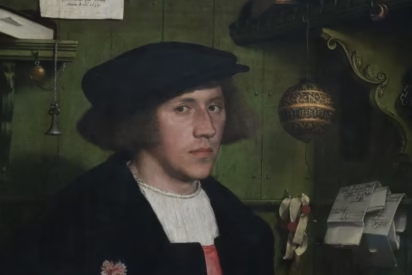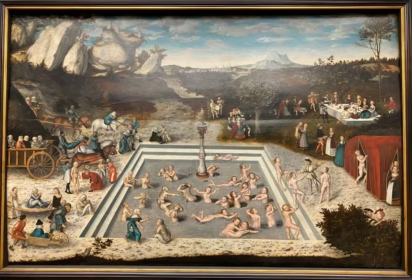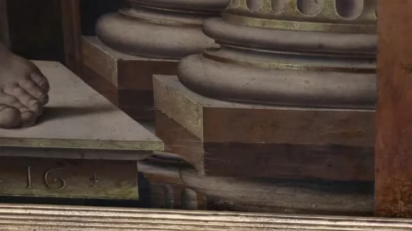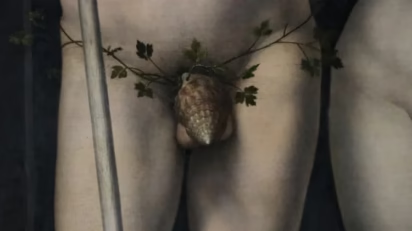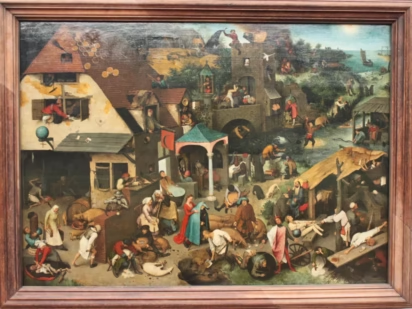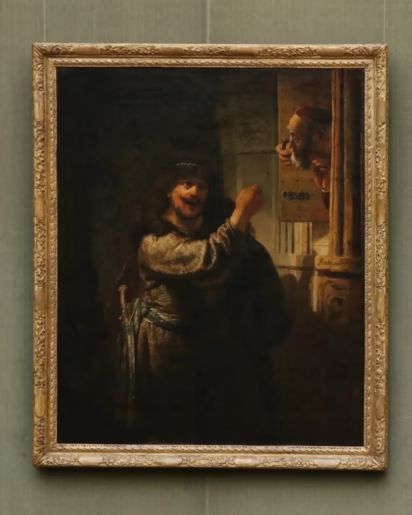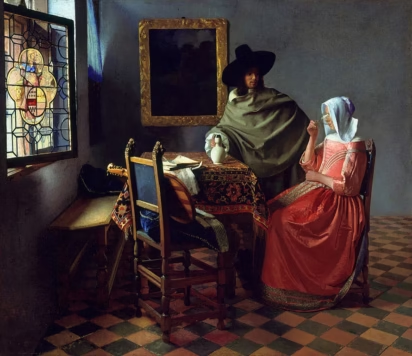Top highlights in the Gemäldegalerie (Paintings Gallery) in Berlin include early German works, Rembrandt and the Dutch Golden Age, Italian Renaissance, and Caravaggio’s Amor Triumphant.

The Gemäldegalerie (Paintings Gallery) in Berlin is one of the most important art museums in the world. It has around 1,300 paintings on permanent display, including works of astonishing quality. The museum covers European Old Masters from the early Renaissance to the classical (ca. 13th to 18th centuries). The collections of Italian Renaissance, early German, and Dutch Golden Age paintings are amongst the best in the world. Caravaggio’s Amor Victorious is possibly the most popular work in the museum but the 16 Rembrandts and two Vermeers receive much attention too. Buy Gemäldegalerie tickets online for skip-the-line admission.
Best Paintings to See in the Gemäldegalerie in Berlin
The Gemäldegalerie in Berlin combines quantity and quality. Most galleries in the world would be delighted to display any ten paintings randomly taken from this art museum’s walls. For visitors, this is a magnificent dilemma — which paintings to study as it is simply impossible to take it all in on a single visit.
The works described below are not an ordered top ten but rather some interesting paintings described in the order of the numbered halls as the route most visitors follow through the museum. It thus starts chronologically with early German paintings, followed by Flemish and Dutch paintings, and the Dutch Golden Age, at the halfway point through the museum. The chronology is reversed starting with European paintings from the 18th century (English, French, Spanish, German) and then the marvelous Italian works — first the popular 17th and 18th-century paintings and finally the astonishing Italian Renaissance collection.
Gemäldegalerie: 200 Masterpieces of European Painting is a beautiful book (but heavy and pricy) — much of the information in the book is available for free when searching the online catalog of the Gemäldegalerie.
→ See also Tips on Visiting the Gemäldegalerie for visitors’ information such as tickets and opening hours.
German Highlights in the Gemäldegalerie in Berlin

German paintings in the Gemäldegalerie date from the 13th to 18th centuries, although the best works are from before 1600.
An early highlight is the Flügel des Wurzacher Altars / Wings of the Wurzach Altar (1437) by Hans Multscher. It has four scenes from the life of Mary and four from the Passion of Christ.
Der Kaufmann Georg Gisze / Portrait of George Giese (1532) by Hans Holbein the Younger shows how far art developed in a century. This portrait of a Hanseatic merchant in his London office is a detailed painting full of symbols and symbolism.
Lucas Cranach in the Gemäldegalerie in Berlin

The Gemäldegalerie has 22 works by Lucas Cranach the Elder (1472-1553) — the German painter most strongly associated with the Reformation. The industrious Cranach was at ease with painting Biblical scenes for both Catholic and Lutheran clients, portraits of Luther and the nobility, expensive clothes and nudes, realism, and mythical figures.
Several of his works are usually on display in the Gemäldegalerie to show his versatility and the breadth of his work:
Der Jungbrunnen / Fountain of Youth (1546) is probably not his best work but it is fun and popular. Old and sickly women arriving on the left and after wading or swimming through the fountain of youth emerged on the right side young and healthy. Venus and Cupid are at the center of the fountain and appropriately two large paintings of Venus and Amor by Cranach are currently displayed on either side of the Fountain of Youth.
Cranach’s Adam and Eve is remarkably similar to his Apollo and Diana.

Another remarkable painting is the Flügelaltar mit dem Jüngsten Gericht / Wingalter of the Final Judgement — around 1525, Cranach painted this accurate copy of Hieronymus Bosch’s altar (now in Vienna) probably on commission from the Elector of Saxony. The small section on the Garden of Eden is fairly normal but the rest of the work is literally hell on earth. The devil really is in the details here. It is quite interesting to compare Bosch’s vision of hell with other paintings in the museum, especially those by Italian painters that were strongly influenced by Dante.
→ More photos of this painting at Flickr.
Albrecht Dürer in the Gemäldegalerie in Berlin
Albrecht Dürer (1471-1528) is probably the most praised German artist. He brought the Renaissance to German art and is famous for his paintings, sketches, and prints.
The seven Dürer paintings of the Gemäldegalerie are not amongst his best-known works but still illustrate his mastery, especially in portrait painting. Dürer’s portrait painting expertise was highly valued by rich clients — he painted numerous emperors and nobility. However, he was not your first choice if you prefer your portrait with filters — he tended to paint warts and all, or as in the case of The Portrait of Hieronymus Holzschuher (1526) complete with a combover.
Die Madonna mit dem Zeisig / Madonna with the Siskin (1506) is an early work he painted while in Venice. It is full of symbolism related to the later beatification of the Virgin and famously has a note with Dürer’s trademark AD sign.
Dutch Paintings in the Gemäldegalerie in Berlin
The Gemäldegalerie’s collection of Dutch and Flemish paintings from the 14th to 17th century is equally praised with the collection of Dutch Golden Age paintings of the 17th century one of the best collections in the world.
Dutch Paintings 14th to 16th Century

The three Jan van Eyck paintings are considered amongst his best works and these early works are complemented by four paintings by Petrus Christus and remarkable altars by Rogier van der Weyden. Further early Dutch works on display are by Hugo van der Goes, Hans Memling, Jan Gossaert, Pieter Bruegel the Elder, and Hieronymus Bosch.
Bosch’s Johannes auf Patmos / Szenen der Passion Christi / John on Patmos / Scenes from the Passion of Christ (1500) is not the riot of his Last Judgment (that Cranach copied) but still anything but straight-laced.
At first glance, Jan Gossart’s large paintings of Neptune and Amphitrite (1516) and Adam and Eve (1525/30) are easily confused. Neptune is the one with the trident and the seashell g-string that tends to attract rather than avert attention from his genitals. Also, note how the pillars are reflected in the water to remind that he is the sea god.
In Die niederländischen Sprichtwörter / The Dutch Proverbs (1559) Pieter Bruegel the Elder illustrated a hundred proverbs in a busy town scene. Dutch, like most Germanic languages, is rich in proverbs, although they were even more commonly used in the 16th than early 21st century.
The painting was previously also known as The Upside-Down World due to the upside-down globe — the Dutch saying the world is standing on its head (De wereld staat op zijn kop!) is still very much in use today. Also note the spilled porridge, which is similar to “spilled milk” in modern English.
Flemish Masters of the 17th Century

The collection of Flemish paintings of the 17th century includes around 200 works of which only a limited number is exhibited. The curators could pick from 17 paintings by Peter Paul Rubens, 7 from Anthony van Dyck, and many by the extended Brueghel family.
Popular Rubens paintings in the museum include Der heilige Sebastian / St Sebastian (1618) that was inspired by Michelangelo statues Rubens saw on a trip to Italy, the Perseus befreit Andromeda / Perseus Freeing Andromeda (1620-22), and the much later Andromeda (1638).
[The largest collection of Rubens paintings in the world is in the Alte Pinakothek in Munich — another German art museum with paintings of astonishing quality.]
Dutch Paintings of the 17th Century (Golden Age)

The Gemäldegalerie’s collection of Dutch Golden Age paintings is amongst the best in the world and probably only surpassed by the Rijksmuseum in Amsterdam. At the core of the collection are 16 paintings by Rembrandt but all Dutch masters from the period are represented.
Rembrandt Highlights in the Gemäldegalerie in Berlin

The 16 paintings by Rembrandt van Rijn (1696-1669) in the Gemäldegalerie include a rare landscape painting, many Biblical themes, famous people of his time, and several self-portraits. These paintings, as well as several from his workshop or circle of influence, are exhibited in Hall X and the nearby cabinets — physically the farthest point from the entrance to the museum.
Popular biblical scenes include Moses and the Ten Commandments, Jacob Wrestling with the Angel, Susanna and the Elders, Samson Threatening his Father-in-Law, Samson and Delilah, and St Johan the Baptist Preaching.
One of his most admired large works in the collection is the painting of the Der Mennonitenprediger Cornelis Claesz Anslo und seine Frau / Mennonite Preacher Anslo and his Wife. As with so many other fine portrait paintings in the gallery, these works are now treasured for the quality of the art rather than the importance of the largely forgotten individuals.
Two Vermeers in Berlin
Only 34 paintings are generally attributed to Johannes Vermeer (1632-1675) with the Gemäldegalerie owning two:
Herr und Dame beim Wein / The Wine Glass and Junge Dame mit Perlenhalsband / Woman with a Pearl Necklace. Although both works are of fine quality, neither is considered amongst Vermeer’s best paintings.
Jan Steen

The gallery has several paintings by Jan Steen showing Dutch society at play, drinking, or fighting but the most fun is the “So de Oude songen, so pypen de Jongen” / Wie die Alten singen, so pfeifen die Jungen / As the Old Sing, So the Young Pipe (whistles) (1665-1670).
Jan Steen painted at least 13 versions of this painting with the Berlin painting quite different from the others. Originally, the painting was more of a merry company in a fine room, but Steen painted out many of the details and made it a lesson in morality. The young will follow the example of the adults — the children on the right are certainly not drinking water, and some boys are most likely smoking in the backyard, or whatever substituted for behind the bicycle sheds in 17th-century Amsterdam.
One of the paintings in the background is a copy of Malle Babbe / Crazy Bappe (1633), a painting by Frans Hals that is usually displayed nearby, showing the influence of drink. This painting is sometimes referred to as The Witch of Haarlem. However, the owl and the tankard hint at a pub scene and the Dutch saying “as drunk as an owl”. Another background painting shows the bad habit of smoking.
18th-Century European Paintings

Except for Italian painters, the museum’s collection of 18th-century paintings is not of the same standard as the earlier works and relatively few are on display. Despite having the largest collection of Spanish paintings in Germany, only a few lesser-known works by famous painters such as Murillo, Zurbaran, and Velazquez (Portrait of a Woman) are shown.
Some German paintings are also displayed here — more from the period are in the Alte Nationalgalerie. Anna Dorothea Therbusch, Selftbildnis / Self-portrait (1782) is a self-portrait posing as a vestal virgin. The special eyeglass always attracts attention.
The Gemäldegalerie’s collection of French paintings is relatively small but Jean-Baptiste Siméon Chardin, Der Zeichner / The Drawer (1737) is a fine sample. It is one of two very similar versions by Chardin — the second is in the Louvre in Paris.
The Gemäldegalerie has the most extensive collection of English paintings in Germany but these are not all top quality meaning only a few are on display. The huge Portrait of John Wilkinson (1775) by Thomas Gainsborough was one of the first notable English works acquired for the collection (in 1904). The equally large Die Marsham-Kinder / Marsham Children (1787) is more appreciated by the modern audience.
→→ Continue to Italian Highlights in the Gemäldegalerie for more on the fantastic Italian collection in the Paintings Gallery in Berlin.
→→See also Tips on Visiting the Gemäldegalerie for visitors’ information such as tickets and opening hours.
Gemäldegalerie: 200 Masterpieces of European Painting is a beautiful book (but heavy and pricy) — much of the information in the book is available for free when searching the online catalog of the Gemäldegalerie.
More on the Berlin State Museums (Staatliche Museen zu Berlin):
Note new opening times for many Berlin museums in 2025 — several are now closed on both Monday and Tuesday.
Timeslot reservations are sensible (and sometimes needed in busy periods) for the Alte Nationalgalerie, Gemäldegalerie, Neue Nationalgalerie, Neues Museum, and Pergamon – Das Panorama. (The Pergamon Museum itself is closed until 2027!). Timeslots are released only a few weeks in advance. Online tickets are available from GetYourGuide or SMB.
Many passes and multi-museum tickets offer savings (Kulturforum / Museums Island). Individual museum ticket prices range from €8 to €14 (€20 for special exhibitions). Online tickets are skip-the-line — go directly to the gallery entrance to scan the code.
For more general information on the Berlin State Museums:
- Top National Museums and Galleries in Berlin (brief overview)
- Berlin State Museums: What Is Seen Where? (a short description of the collections in the different museums)
- Opening Hours of Berlin State Museums (2025) — major changes since mid-April 2024!
- Ticket Prices for Berlin State Museums (prices for museums, temporary exhibitions, combination tickets, online time-slot reservations). Buying online from GetYourGuide is easy. A ticket with a QR or bar code is scanned directly at the entrance — no need to pass by the ticket desk (but pick up the free audio guide before entering).
- Save with the Berlin Museum Pass – 30 museums (including all the SMB museums) in three days for €32 – a fantastic savings deal.
- Staatliche Museen zu Berlin (official website in German & English).
News & Temporary Exhibitions in Berlin in 2025:
- 2025: Top Special Art Exhibitions in Berlin in 2025 & Top Contemporary Art Exhibitions in the Hamburg Bahnhof.
- Museums closed in 2025: The Pergamon Museum is closed until 2027 (some sculptures are on display in Das Panorama), the Museum Berggruen is closed until 2026 (much of its collection is traveling the world), the permanent collection of the German History Museum (Zeughaus) is closed but temporary exhibitions continue in the Pei Building.
More Museum Reviews and Museum-Specific Information:
- Alte Nationalgalerie — 19th-century art.
- Altes Museum — Greek, Etruscan, and Roman art.
- Bode Museum — sculptures from the Middle Ages, Gothic, Renaissance, Baroque, and Classical periods, Byzantine Art, and coins.
- Ethnological and Asian Art Museums in the Humboldtforum.
- Friedrichswerdersche Kirche (free admission) with a collection of 19th-century German sculptures.
- Gemäldegalerie — German and Dutch Old Masters and Italian paintings.
- Kunstgewerbemuseum (Decorative Arts).
- Musical Instruments Museum near the Berliner Philharmonie.
- Neue Nationalgalerie — 20th-century art.
- Neues Museum — Pre and Early History, Egyptian Collection with bust of Nefertiti.
- Pergamon Museum with Ishtar Gate — the whole Pergamonmuseum is closed from 2023 until 2027. Some Greek sculptures are shown in the
- Pergamon Museum Panorama Exhibition with Asisi panoramic painting and Greek statues.
- Photography — Helmut Newton collection and historic photos.
Previous Temporary Exhibitions in Berlin Museums:
- 2024: Overview of Top Berlin Exhibitions in 2024, Caspar David Friedrich in the Alte Nationalgalerie, Frans Hals in the Gemäldegalerie, Neue Nationalgalerie (20th-century art) Hamburger Bahnhof Contemporary Art, Kupferstichkabinett (Prints and Drawings), and Photography Museum.
- 2023: Top Special Temporary Exhibitions in 2023 — overview, in the Kulturforum, in the Neue Nationalgalerie, on Museum Island, and the Museum of Photography.
- 2022: Top Special Temporary Exhibitions in 2022 — overview, in the Kulturforum (David Hockney), in the Neue Nationalgalerie, on Museumsinsel, Hamburger Bahnhof contemporary art, and the Museum of Photography.
- 2021: Top Special Temporary Exhibitions in 2021 — including the reopening of the Neue Nationalgalerie, as well as the Ethnological and Asian Art Museums in the Humboldt Forum.
- 2020: Highlights, in Kulturforum, on Museum Island, in the Hamburger Bahnhof, smaller museums, and the opening of the Humboldt Forum.

